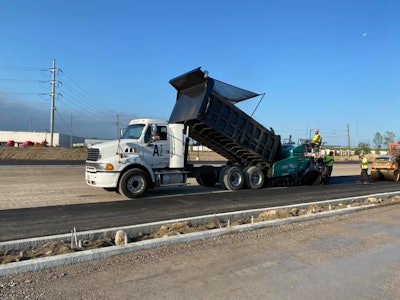
Telematics can put the right data in the right hands at the right time to save a company time, labor and stress. But for many managers, knowing when and how to implement telematics technology can be daunting. However, if done correctly, implementing telematics can increase productivity, efficiency and morale.
Doing More With Less
Telematics shows company representatives where their trucks are at all times. But more than that, it gives managers and foremen the ability to see trends in data and compare different datapoints. Being able to see where one truck is at any given time helps managers plan and oversee their fleets. But one truck’s data becomes invaluable when you compare it to the rest of the trucks on the job. In order to make the changes that will increase efficiency at the job site, managers have to see the whole forest—not just a single tree.
An asphalt trucking company in Florida installed Earthwave Technologies’ FleetWatcher Materials Management Solution. The system showed them data on all their trucks across several job sites. By looking at the bigger picture, they were able to see that they were averaging eight trucks waiting to be loaded at any given time throughout the day. That added up to an hour wait time per cycle, and three and a half hours of idle time per day. The company was paying $350 a day for a truck to wait in line.
They were over-trucked and could see it when they looked at the bigger picture—the data trend over time. The company quickly shared the information with the plant, sent out fewer trucks at a time, and shaved 75% off the idle time.
That’s what telematics is all about: getting that data to the right people in the right amount of time so that they can proactively make business decisions before it’s too late.
Go Big
Rather than starting a telematics system at the start of the season, implement it at the start of a high-impact job. Often companies are trying to do a lot of different projects at the start of the season, and some projects, like implementing a telematics system, fall by the wayside when the company gets busy.
Big, make-or-break-the-year projects get the most amount of resources, and provide the largest possible data-set. The more trucks are out, the more datapoints a company will be able to collect. With more datapoints, trends will be clearer, comparisons will be sharper, and managers will be able to see the bigger picture. When a manager notices a job is over-trucked and makes an adjustment, the result will be clearer too: more productivity, less downtime.
Whenever you can devote the right amount of resources to it, that’s the best time to implement telematics.
Many companies turn to telematics when it’s too late. Many a manager has turned to ask for help after spending the trucking budget for the year or a crisis has occurred on a high-impact project. Only then do they realize there’s technology that can solve the issue they’ve run into. Get the system implemented early and avert the crisis in the first place.
The Big Brother Factor
With managers receiving real-time data on routes and drive time from their drivers, many companies are nervous that employees will feel like they’re being micromanaged. However, with transparent and proactive communication, managers can dispel the Big Brother Factor before it is even established.
Drivers buy in to telematics systems when they understand why and how the system is being implemented. Show the drivers that telematics is a win-win situation: the company gets real-time data that allows them to strategize how to use the drivers to increase productivity. Meanwhile, the drivers get to drive, rather than wait in lines. In some cases, companies have even forwarded the influx of cash from increased productivity to drivers in the form of a pay raise.
Transparency is another tool to earn employee support. Managers should show drivers how the data looks from their perspective, including what they see and how they intend to use it. It shouldn’t be a behind the curtains thing.
No Time Like Now
With companies relaxing quarantine restrictions, many are looking for ways to implement the “new normal” of social distancing and working from home. Of course, working from home isn’t possible for many industries, such as trucking or asphalt paving.
Telematics can help companies adjust to these changing times. A Construction or Materials Management Solution can track and transfer data from the jobsite or plant to a foreman, manager or executive without that person having to go knock on the door at the site. Managers can access and analyze information while working from home, reducing the need for contact and exposure.
E-ticketing is another way telematics can reduce exposure. E-ticketing tracks and transports data without paper printouts or physical contact. With more and more states tracking contact, e-ticketing has become a high priority.
On top of that, with uncertain markets and budget cuts looming, many companies are looking at how to do the job with less people. Some are trying to reduce the cost of a job while others are trying to free up employees for other projects. With real-time data delivered into the right hands, companies can begin to re-strategize how to use their employees more effectively.
By being proactive about implementing telematics, companies can introduce the system in a way that increases buy-in from employees across the board. Getting a jump start on introducing telematics early in a season helps companies see the bigger picture faster. More data means a clearer picture, and a manager can adjust productivity before it’s too late. Being proactive allows companies to start saving time and labor on projects now, rather than waiting for a crisis or budget shortage to start looking for ways to save.
Jim Wahl is owner of Wahl Marketing Communications and can be reached at [email protected]

















